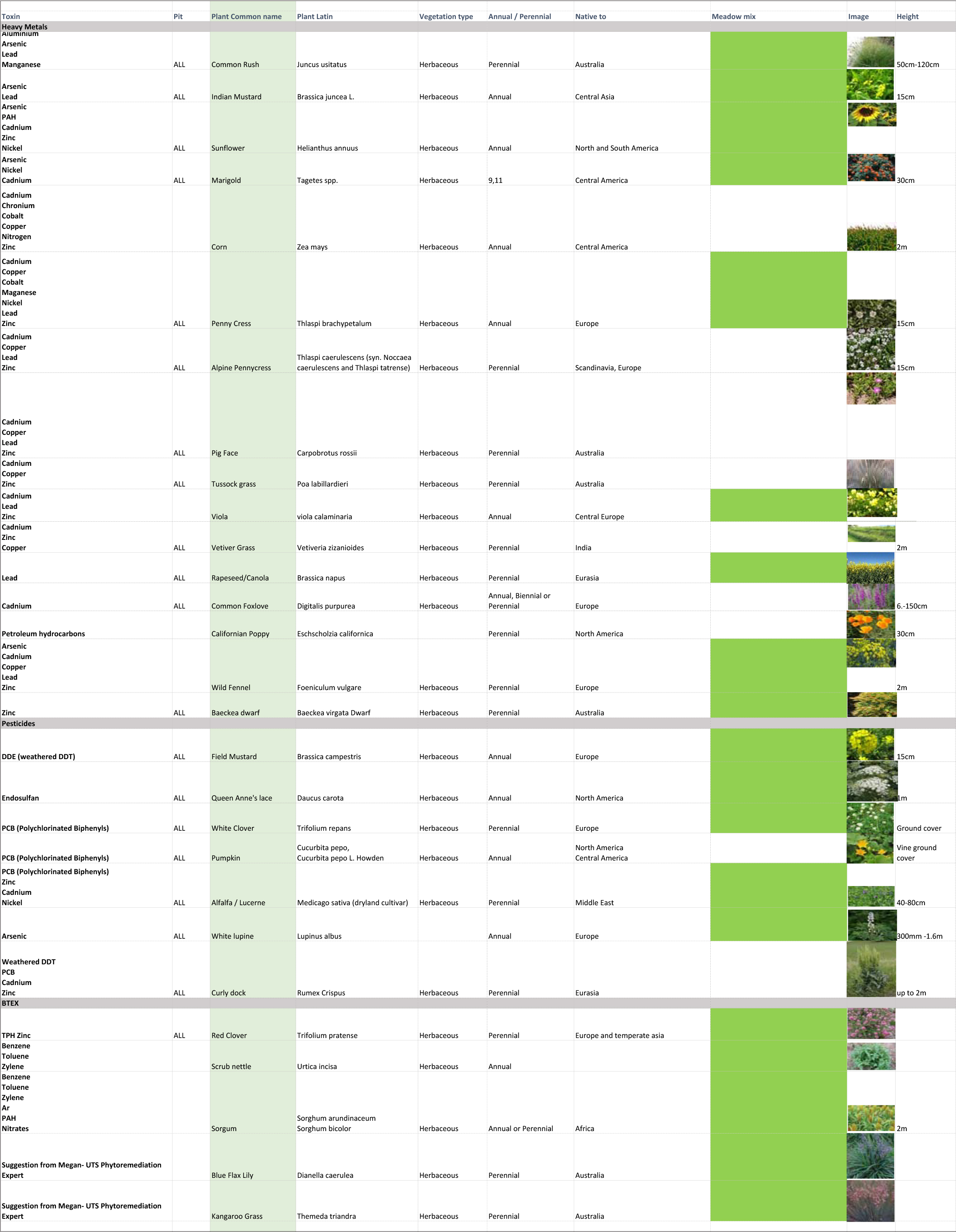GARDEN 01 DESIGN
DESIGN AGENDA
The Power Plants Phytoremediation Garden was implemented during August 2018. It incorporated a palette of annual, fast growing plants in which a large portion of the selected species originate from agricultural industries. The plant species were selected from phytoremediation research and were proven to remove toxins in previous field and laboratory experiments. Plant selection was further influenced by matching appropriate species with the known toxins found on site, as well as included plants which have notable bloom and foliage qualities.
The garden utilised annual plants species to specifically test phytoremediation rates in a relatively short period of time and provide floral and foliage interest. The planting remained experimental and the results were greatly influenced by the specific site conditions (known and unknown at the time planting) at White Bay Power Station. The planting plan while privileging toxin removal also improved soil microbiology and nutrition. The research team had further aspirations for the garden to contribute to local green infrastructure and enhance the existing site before its eventually redevelopment.
CONCEPT DESIGN FOR GARDEN 01
0-3 months of vegetattion growth post seeds being sown
3-6 months of vegetation growth post seeds being sown
The 1000 sq metre garden was divided into ten 100m² plots (roughly 10m x 10m plots) . The planting design concept included two plot types; monocultures and meadows.
MONOCULTURE
The monoculture plots were 2m in diameter demarcated using irrigation pipe, arranged in a grid of five plots by five rows for a total of 25 subplots. Each circular subplot was hand sown with a single species. This type of planting regime explored specific plant performance in relation to growth and toxin removal, without competition from other plants. The space between the pipe circles allowed for spontaneous growth and spread to occur. The monoculture plot sections were planted to illustrate colour variety, height variability, foliage and textural variability as well as structural interest throughout the year as foliage, flowering and seed heads formed and died back.
MEADOW MIX
The meadow mix plots contained a variety of seeds mixed together and sown directly into 100m² meadow sections. This planting regime explored the potential of companion species and sought to create the ideal rhizosphere conditions for toxin removal. The meadow designs sought to be random and organic in their structure, colour, and height.
Meadow plots and Monoculture plots were alternated across the length of the site. This was to offer visual contrast, quick comparison, and to equalise adjacent site conditions for both the plot types. Thus, replicating the experiment across the site.
The research team encountered a few unknowns during the construction of the garden. A concrete slab was discovered under the first four plots so the soil depth was roughly 200-250mm while the other remaining plots had a soil depth of roughly 500 mm. All plots were irrigated regularly to enhance plant establishment and growth. The soils were not amended but a layer of hydro mulch was applied after the seeds were planted to minimise predation of seeds by birds.
CROSS SECTION THROUGH GARDEN
Image illustrating the planting logic of the monoculture pipe circles. The design anticipated the heights of each plant circle bed to form a terrace or layering of plant species. The colour grid indicated foliage, flower, seed head and fruit interest during different seasons.
Species selection + soil contaminants
The plant selection was based on the soil conditions on site, these included a range of contaminants. Due to the industrial history of the site the key contaminants that informed the species selection were heavy metals, in particular: Copper, Lead, Nickel, Chromium and Zinc.
The below image details the species selected, and which contaminants previous research suggests they will absorb.
Note: The contaminants listed are not all present on the site, they have been indicated in previous literature as reacting with the selected plants species - they are not to be taken as a list of existing contaminants on this site, but as the full scope of the species recorded ability to phytoremediate.





